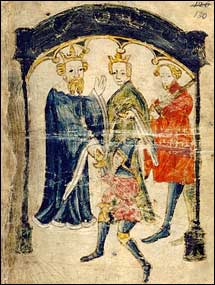
Gawain is the eldest son of Lot of Orkney and Morgause (though his mother is said to be Anna in Geoffrey of Monmouth). He is the nephew of King Arthur and one of his closest companions. He is the brother of Gareth, Gaheris and Agravaine, and the half-brother of Mordred.
Gawain, along with Bedivere and Kay, appears in some of the earliest Arthurian writings. Gawain features in early Welsh poetry as Gwalchmai, Walwen, or Gauvain. Geoffrey of Monmouth's History of the Kings of Britain equates Gawain and Gwalchmei. Geoffrey chronicles that Gawain was in command of a division in Arthur's army in their victory over the Roman Emperor Lucius at the Battle of Saussy.
As a character Gawain has changed over time. The earlier legends cover more his feats in battle, as in Kilhwch and Olwen. But in the later romances Gawain has become womanizing and vengeful. In Le Morte Arthur, Gawain threatens to kill Lancelot for his dishonor to the queen, king, and his brother, Agravain.
Wirral Forest features in the fourteenth century alliterative poem Sir Gawain and the Green Knight. Gawain goes through Wirral Forest on his way to the Green Chapel. At the time the poem was written, Wirral was a royal forest and would have been dark and menacing. In this story, Gawain is shown be loyal knight and virtuous knight whose one failing is to reveal the existence of a magical talisman. Gawain fearlessly accepts the Green Knight's two challenges, and returns to Camelot a hero.
Gawain was killed as he came back to Britain to fight Modred. As with many King Arthur characters, there are various thoughts on his burial place. It would appear to be in St. Govan's Chapel near Bosherston,in Pembrokeshire. The myth that Gawain is buried on the Pembrokeshire coast is older and more probable than the Dover Castle claim. The church consists of a simple nave with a stone altar on east that supposedly contains the remains of Sir Gawain.
Caxton, in his preface to Malory's Morte Darthur, writes "In the castle Dover, ye may see Gawain's skull" The skull certainly does not exist there today and most scholars doubt the validity of this claim.
Chretien de Troyes early works portray Gawain as a mighty knight second only to Lancelot at the Round Table. But as Chretien wrote his stories Lancelot and Perceval have tended to come more to the fore, Gawain became less important. In Chretien's Perceval storys, although unfinished, the reader can well conclude that Gawain will not achieve the Grail Quest.
Later writers, especially Malory and Tennyson, have continued to portray him in an unflattering light, as a source of irritation to the king and a proud, stubborn, old knight.
Modern writers, such as Marion Zimmer Bradley, portray Gawain as a proud head of a clan, the oldest of the brothers Orkney at Camelot.
Full references to more about Sir Gawain at the Rochester site
No comments:
Post a Comment